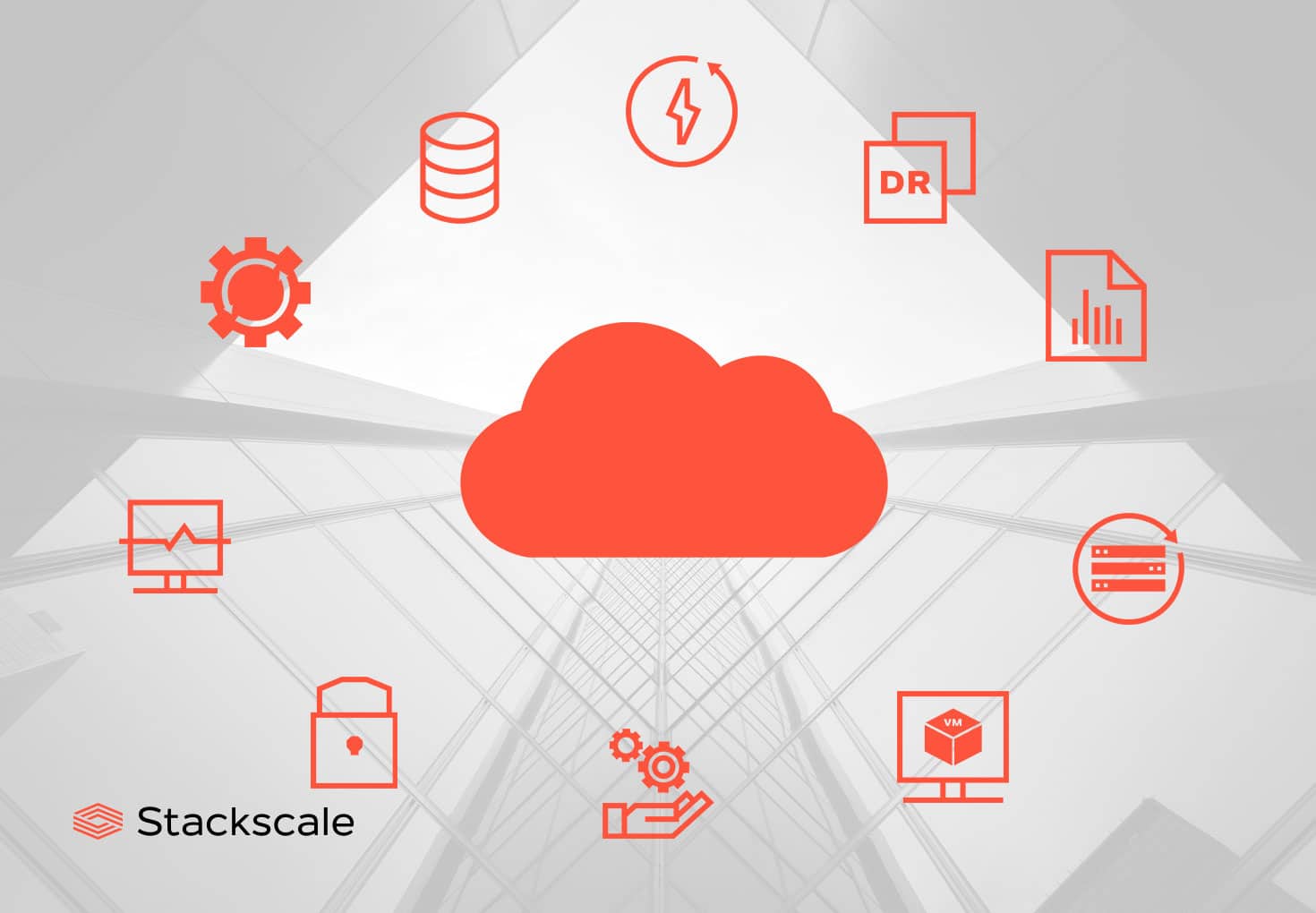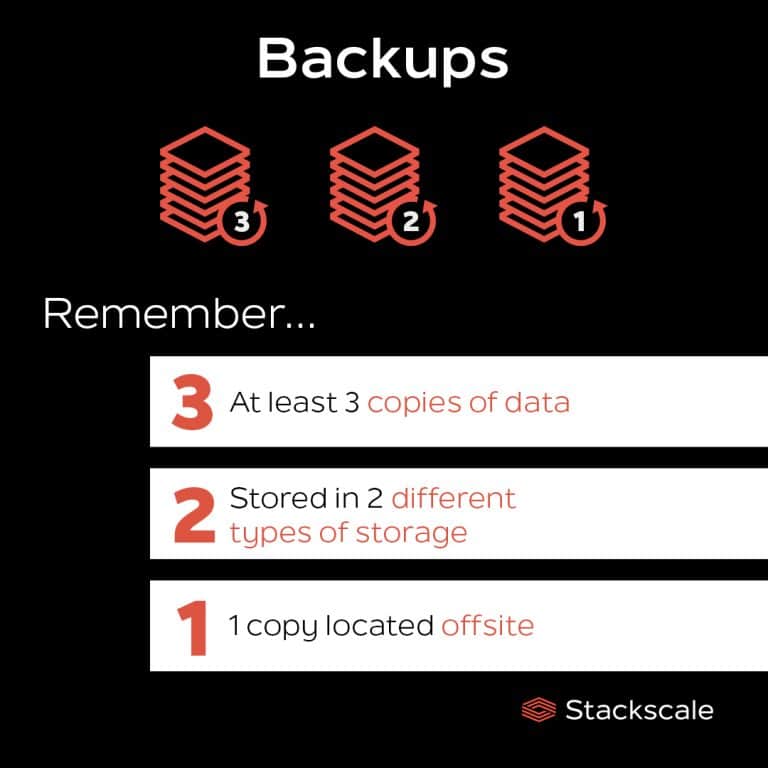Cloud computing is more than a trend nowadays. It has become part of our daily lives, both among businesses and individuals.
This guide about cloud computing aims to cover the most important aspects of this IT services distribution model. As well as some trends that are closely related to its evolution.
Chapter 1: What is cloud computing?
Cloud computing is a computing resources and services distribution model over the Internet — from applications to storage resources, networking and processing capabilities. It is not a technology, but a way of accessing resources and capabilities based on numerous technologies. Based on an on demand, pay per use model, it aims to help businesses increase efficiency and competitiveness, as well as encourage innovation.
When opting for a cloud computing solution, applications, workloads and data are moved from an on-premise data center to a remote data center managed by a service provider.
Benefits of cloud computing
Cloud computing offers many benefits both to organizations and users.
- On demand service. Users can use applications, services and computing resources on demand, paying a monthly fee.
- Elasticity and scalability. Users can easily increase and decrease the contracted resources depending on their real needs.
- Innovation. Cloud computing enables companies to innovate easier and faster, in all departments, not only IT.
- Cost-effectiveness. Organizations can reduce both capital (CAPEX) and operational expenses (OPEX).
- Mobility and availability. Cloud computing solutions can be used from anywhere in the world, using any device.
Cloud security
Cloud security is a top priority for providers, and it must be so for users and companies alike. The level of security in cloud platforms is often as good or even better than that achieved in traditional IT environments. However, it is essential to keep in mind that migrating to the cloud entails changing to a shared-responsibility model. It is to say: the cloud service provider is responsible for the security of the cloud and the customer or company is responsible for the security in the cloud.
Interoperability and standardization
There is still a lot of work to do regarding interoperability and standardization to avoid vendor lock-in issues. Improvements in this regard are important not only for organizations, in order to be able to change workloads between providers or solutions without constraints, but also for the model’s successful adoption and evolution. In this regard, using open standards and protocols is key.
Chapter 2: Cloud adoption
It is expected that cloud adoption continues to grow. Regarding the Infrastructure as a Service model, Amazon Web Services (AWS), Microsoft Azure and Google Cloud Platform (GCP) continue to lead the cloud market by revenue. Nevertheless, alternative cloud providers have a lot to offer with the growing, continued adoption of hybrid cloud and multi-cloud models.
Public cloud services are expected to grow about 21% in 2023, from about $490 billion in 2022 to more than $590 billion in 2023, according to Gartner’s predictions. As for private cloud services, the market is expected to grow at a 29.7% CAGR from 2022 to 2029, until reaching $528 billion, according to Maximize Market Research. Furthermore, it is also worth mentioning that the adoption of open source cloud infrastructure technologies like OpenStack is also on the rise.
Cloud adoption worldwide
Cloud adoption worldwide is around 90%, according to the The Cloud in 2021: Adoption Continues report from O’Reilly. The report is based on a survey carried out by O’Reilly among the subscribers to their Programming and Infrastructure & Ops Newsletters. So, although respondents come from organizations from all continents (except for Antarctica), the real percentage of cloud adoption in the world is difficult to estimate.
Cloud adoption in Europe
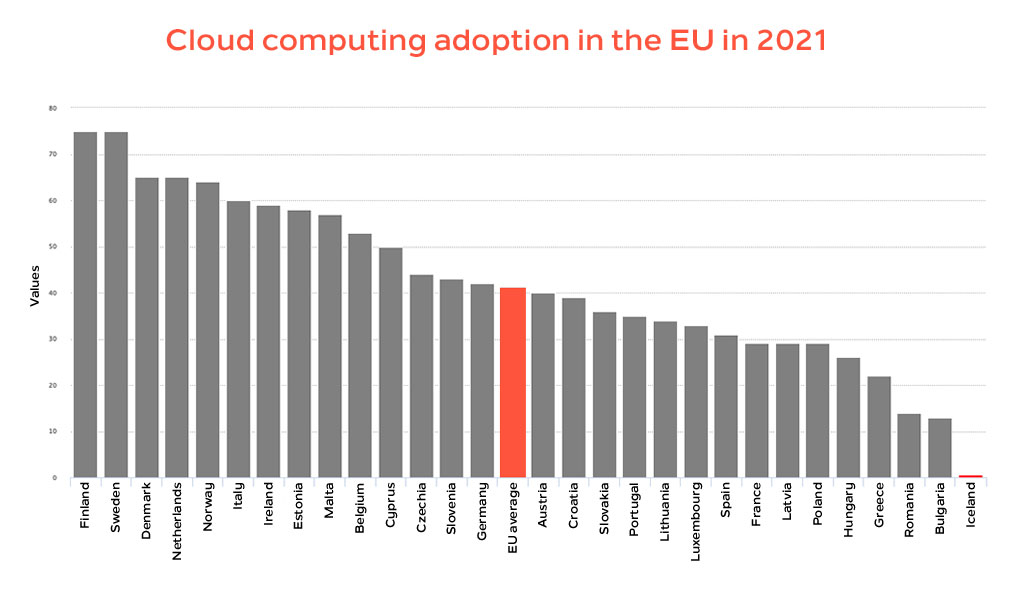
Cloud adoption rates vary considerably among countries. As of 2021, on the one hand, Sweden (75%), Finland (75%), Netherlands (65%) and Denmark (65%) lead the adoption of cloud computing among enterprises in the European Union. On the other hand, Bulgaria (13%), Romania (14%) and Greece (22%) are the countries with the lowest cloud adoption rate. In the case of Iceland, as shown in the graph above, there is no data available.
Chapter 3: Cloud service models
Each cloud service model covers different user and company needs, and provides a different level of control, security and scalability.
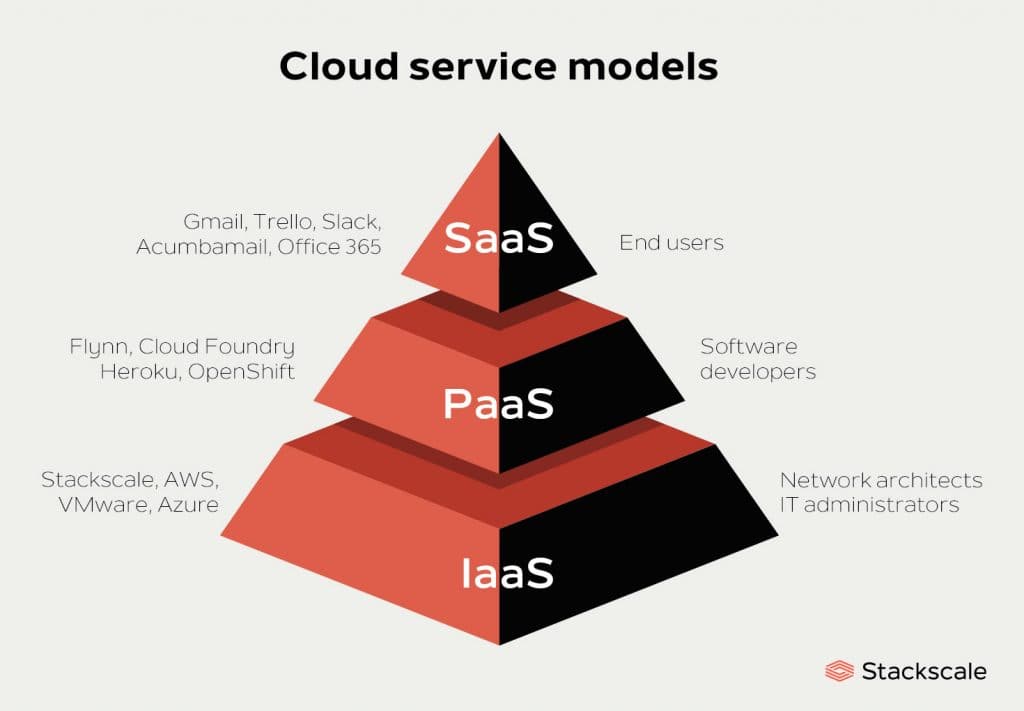
IaaS | Infrastructure as a Service
The IaaS cloud service model consists of provisioning and managing computing resources over the Internet; such as servers, storage, networking and virtualization. Infrastructure as a Service provides the technology and capabilities of high-standard data centers to businesses without a significant capital investment on IT equipment.
This cloud service model allows companies to purchase computing resources on-demand, instead of buying their own hardware. This reduces setup, management and maintenance costs and increases efficiency, scalability, redundancy and security.
| Managed by the customer in the IaaS model | Managed by the provider in the IaaS model |
| Applications | Servers |
| Data | Storage |
| Runtime | Networking |
| Middleware | Virtualization* |
| OS | |
| Virtualization* |
*Virtualization can be managed either by the customer or by the cloud service provider, depending on the solution.
PaaS | Platform as a Service
The PaaS cloud service model provides a ready-to-use development environment, where developers can focus on writing and executing high-quality code in order to create customized applications.
Platform as a Service allows developers to build scalable and highly-available applications without worrying about the OS, storage or updates. It provides a framework developers can use for developing, managing, distributing and testing software applications.
| Managed by the customer in the PaaS model | Managed by the provider in the PaaS model |
| Applications | Runtime |
| Data | Middleware |
| OS | |
| Virtualization | |
| Servers | |
| Storage | |
| Networking |
SaaS | Software as a Service
The SaaS cloud service model consists of delivering cloud-based applications to users over the Internet. SaaS is the most widespread model, it is widely used by companies to build their businesses, as it is easy to deploy, use, manage and scale.
SaaS cloud providers host applications in their network and users can access them from different devices, using a browser or an app. SaaS solutions are made available to customers on a subscription basis or for purchase.
XaaS | Anything as a Service
The term “XaaS” is used to refer to the delivery of any product, tool or technology as a service. IaaS, PaaS and SaaS are the main cloud service models, but there are many other products and solutions that are delivered as a service nowadays. For instance:
- BMaaS or Bare Metal as a Service — also known as MaaS or Metal as a Service.
- DRaaS or Disaster Recovery as a Service.
- BaaS or Backup as a Service.
Chapter 4: Types of cloud
When migrating to the cloud, there is no “one-size-fits-all” type of cloud for all businesses. Each type of cloud offers different advantages. Therefore, the right model for an organization will depend significantly on its needs and goals.
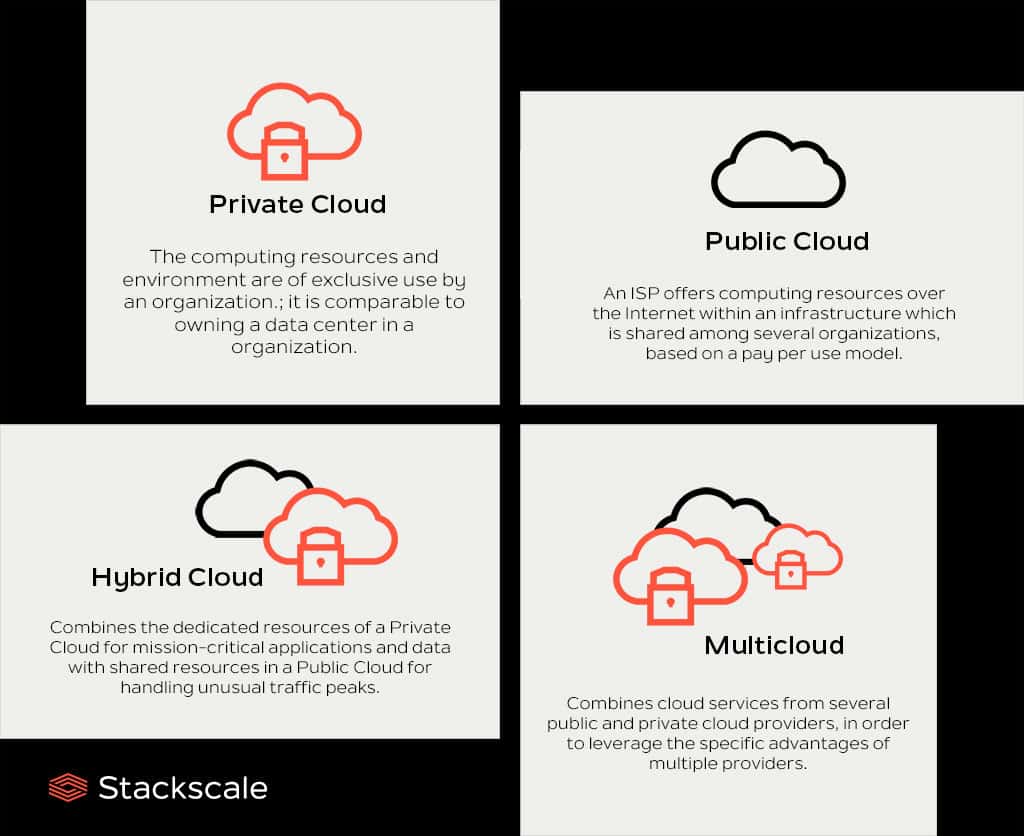
Private Cloud
The Private Cloud is a cloud computing deployment model in which the environment and computing resources are of exclusive use by the customer. That is why it is the most common type of cloud to host mission-critical data and applications demanding strict performance, availability and security requirements.
Private cloud environments allow companies to forget about the management of on-premise servers at the same time it accelerates provisioning and deployment procedures. Besides, opting for a hosted Private Cloud in a specialized data center, as those we design at Stackscale, provides much more value and advantages to companies.
Public Cloud
The Public Cloud is a cloud computing deployment model in which computing resources are shared among several customers. Public Cloud environments are known for being extremely flexible and scalable, but since they run on an infrastructure shared with more customers they have some disadvantages compared to dedicated cloud solutions.
In some cases, performance can be negatively affected by the activities of noisy neighbors, due to the oversubscription of resources. Besides, when opting for a Public Cloud environment, it is very important to carefully keep control of the contracted resources.
Hybrid Cloud
The Hybrid Cloud is a cloud deployment model which combines public and private computing resources. Hybrid Cloud solutions combine the previous two types of cloud: the Private Cloud for mission-critical applications and data and the Public Cloud for handling unusual traffic peaks.
Guaranteeing a good interoperability between both environments is essential in a hybrid cloud solution, so that its management is agile and efficient.
Multi-cloud
Multi-cloud is a deployment model which combines cloud services — both private and public — from several cloud providers. This is especially interesting for big and complex projects, but it is also very demanding in terms of management and security. Nevertheless, just as in hybrid cloud solutions, guaranteeing the interoperability among the environments is essential to ensure an efficient and agile management.
When opting for a multicloud approach, one of the solutions can be used, for example, as an infrastructure reserved for Disaster Recovery.
Chapter 5: Cloud migration strategies
Cloud migration strategies generally refer to migrating applications, data and workloads from an on-premises infrastructure and architecture. Although the migration can also be done among different cloud solutions or types. These are the main cloud migration strategies:
Rehost or “Lift and Shift”
The rehost or “Lift and Shift” migration strategy consists of moving workloads and applications into the cloud exactly as they are in the on-premise infrastructure. In other words, companies basically “lift” applications from its in-house data center and “shift” them to a cloud environment — either a Private Cloud as those we provide at Stackscale or a public cloud—, without significant changes.
Refactor or “Lift, Tinker and Shift”
The refactor or “Lift, Tinker and Shift” migration strategy consists of partially adapting and optimizing applications, so that they better fit the cloud environment. However, it only involves a few cloud optimizations and adjustments, without modifying the core architecture.
Revise
The revising migration strategy consists of implementing major changes to the systems and applications’ code and architecture being migrated to the cloud. So that they can fully leverage the services available in the cloud — either a private cloud or a public cloud.
Rebuild
The rebuilding migration strategy consists of discarding and replacing the existing code. As it involves a bigger time and monetary investment, this approach is only considered when an existing solution no longer meets the business needs.
Repurchase or replace
The repurchasing or replacing migration strategy consists of migrating to a different solution or product. When choosing this approach, data is usually just migrated to a third-party application offered by a provider.
Cloud-to-cloud migration
The cloud-to-cloud migration strategy consists of moving applications and workloads from one cloud provider to another. Either because the company’s needs and goals have changed and another cloud provider is more suitable, or because it aims to change to another type of cloud or to a different cloud service model.
Chapter 6: Cloud and digital transformation
The growth potential of the digital economy encourages more and more businesses to shift to new, disruptive technologies and methodologies, and the Cloud is always at the core.
Cloud computing adoption is an essential step in digital transformation processes, as it enables the modernization of IT infrastructures with a lower initial investment. This way organizations can accelerate their transformation and increase competitiveness, by leveraging further agility, scalability and productivity, among other advantages.
Throughout the digital transformation process, cloud services are an important foundation for improving many aspects, such as:
- Decentralization.
- Flexibility to grow.
- Data-driven decision making.
Chapter 7: Cloud computing trends
The widespread adoption of cloud computing has led to many developments and innovation in different areas such as security and connectivity. Let’s see some of the trends that are rising together with cloud computing.
Edge computing
Edge computing is a distributed computing paradigm that consists of bringing data storage and computing closer to where data is generated. It is closely related to CDN solutions. This edge is rising due to the exponential growth in the number of connected devices driven by the Internet of Things.
DevOps and DevSecOps
DevOps stands for “Development and Operations”. It is a methodology under which, development (Dev) and operations (Ops) departments join efforts to make developments and deployments as agile as possible. Instead of working separately, as it has been traditionally so. By doing so, this methodology aims to release better software, faster, using agile principles and best practices. As for the DevSecOps model, it consists of integrating the security layer from the beginning within the DevOps methodology.
In both cases, the cloud serves as a foundation for boosting collaboration across teams and improving agility from the development to the production stage.
FinOps
FinOps stands for “Financial Operations”. This financial management discipline is gaining popularity as a methodology to improve cloud costs management. It consists mainly of tracking, analyzing and optimizing all costs associated with cloud computing usage.
Containerization
Containerization is a major trend in software development and it is changing the way resources are deployed in the cloud. It enables, for instance, greater portability between different cloud solutions.
SD-WAN
SD-WAN is short for software-defined Wide Area Network, a cloud-oriented approach to manage Wide Area Networks (WANs). It is a virtual Wide Area Network architecture designed to simplify and optimize branch office network connectivity.
Zero Trust
Zero Trust is an approach to the design and implementation of IT systems based on the principle of “never trusting, always verifying” every device. Zero Trust is highly recommended for organizations relying on cloud solutions and working from different locations.
Disaster Recovery
Cloud computing has also made Disaster Recovery solutions affordable for companies of all sizes. A Disaster Recovery plan is essential for protecting an organization’s data and functionalities against any contingency that may occur.
Moreover, relying on geographically distributed data centers contributes to building a stronger business continuity strategy. Georedundancy strengthens the DR strategy and minimizes impact on the service.
Cloud repatriation
Cloud repatriation is gaining popularity among CIOs and CTOs to achieve higher performance, control and cost efficiency as their projects evolve and scale. It is a valuable tool to relocate workloads when the cost-benefit ratio is not as expected. It generally involves migrating to a dedicated solution that works best for running the business workloads.
Artificial Intelligence
Artificial Intelligence is a discipline focused on creating intelligent machines and computer programs that are able to imitate problem-solving and decision-making capabilities inherent to human intelligence. This favors automation and innovation, thus boosting customer experience, competitiveness and growth.
Sovereignty
Data and cloud sovereignty are also on the rise. As data becomes more and more valuable for individuals, organizations and institutions, data sovereignty, protection and privacy have become key aspects for building trust and creating added value.
Download the complete guide about cloud computing

